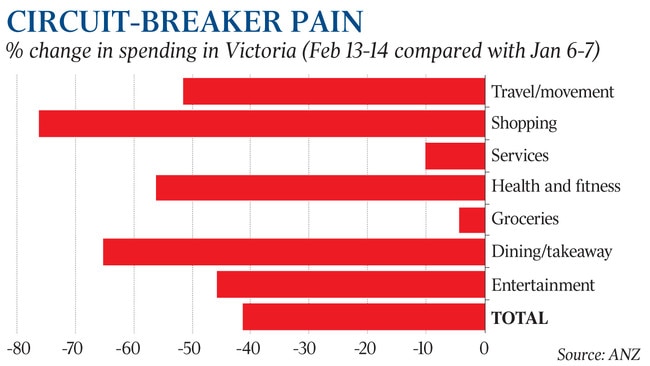Melbourne spending slumps 41pc as coronavirus lockdown bites
Spending slumped by 41 per cent over the first two days of Melbourne’s harsh ’circuit breaker’ lockdown.

Spending slumped by 41 per cent over the first two days of Melbourne’s harsh “circuit-breaker” lockdown, bank data has revealed, as new payrolls figures showed rolling restrictions had left Victoria well behind the national jobs recovery in late January.
The first two days of Melbourne’s latest lockdown triggered a 76 per cent collapse in shopping spending, and a 65 per cent drop in dining and takeaway expenditure, ANZ card transaction data showed.
The consumption crunch echoed the impact of recent short, sharp lockdowns in Perth and Adelaide, both of which were followed by a swift rebound that put spending back at previous levels, ANZ economist Adelaide Timbrell said. “We expect the recovery in spending will be very rapid if the circuit-breaker lockdown ends as planned,” she said.
Spending on ANZ cards nationally over the week to February 14 offered a brighter picture, up by 14 per cent year on year.
Ms Timbrell said the headline spending numbers reflected “some resilience among household spending — despite the Victoria lockdown and closed borders — as the economy continues to improve”.
The Australian Bureau of Statistics figures showed the number of Victorian employees in the Australian Taxation Office’s single-touch payroll system in the final week of January remained 1.7 per cent lower than a year earlier.
Nationally, the ABS numbers showed a 1.3 per cent lift in payroll jobs between the weeks ending January 16 and 30, putting the number of employees nationwide at the same level as a year before.

The payrolls report provided further evidence the post-COVID labour market recovery extended into 2021, despite a summer of brief lockdowns and border closures. New National Skills Commission data showed job vacancies recorded a ninth consecutive month of gains in January, climbing 1.6 per cent, or 2800 advertisements to 175,100 – 11.1 per cent higher than a year earlier.
Official labour force statistics due on Thursday are expected to show a 30,000 lift in employment in January, and a drop in the jobless rate from 6.6 per cent to 6.5 per cent, based on consensus economist forecasts.
Overall employment in Australia remains around 90,000 below pre-pandemic levels. Last week the Department of Social Services reported about 100,000 fewer JobSeeker recipients last month, although the number of Australians on welfare remains well above pre-pandemic levels.

Consumer confidence is around 10-year highs, buoying hopes households will continue to spend beyond the end of major income support measures in late March.
In the two other eastern states, the ABS report showed a similar picture of a payroll jobs recovery that is largely complete: NSW weekly payrolls were 0.1 per cent down versus a year ago; Queensland was 0.2 per cent higher.
The ABS figures also showed 3.5 per cent more payroll jobs in the Northern Territory than a year ago, and around 2.5 per cent more in Western Australia and South Australia.
Tasmanian weekly payroll jobs were tracking 1.7 per cent below 2020 levels.




To join the conversation, please log in. Don't have an account? Register
Join the conversation, you are commenting as Logout